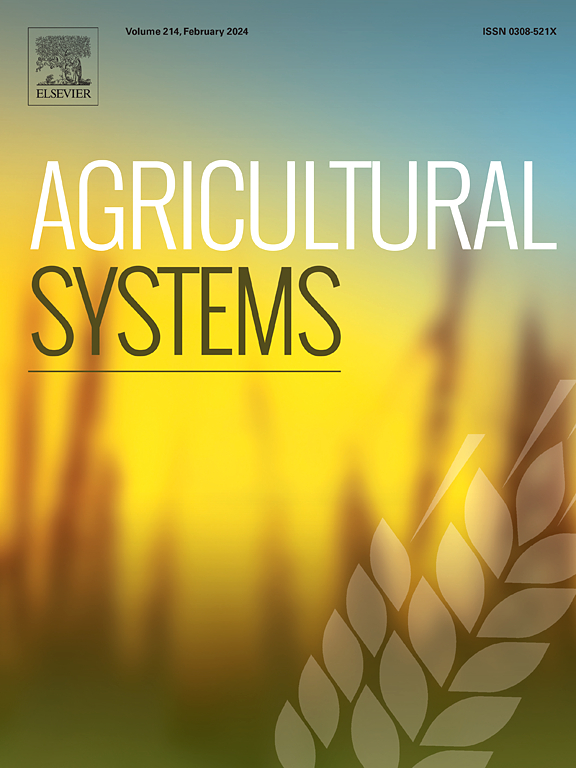从斑块到围场的规模:基于利尿剂的尿斑淋滤和氧化亚氮排放缓解在所有规模和放养率下有效吗?
IF 6.1
1区 农林科学
Q1 AGRICULTURE, MULTIDISCIPLINARY
引用次数: 0
摘要
温带草原是农业生产的重要贡献者,但也通过N2O排放导致全球变暖,并通过n的浸出导致当地水质问题。这些排放主要是由小而集中的尿斑驱动的。在反刍动物日粮中添加利尿成分可降低单个尿斑的氮负荷,但不会改变牧草的总氮归还量。在斑块尺度上,降低氮素负荷的有效性已得到证实。然而,利尿剂也会增加尿斑的数量和大小,目前尚不清楚这将在多大程度上抵消围场水平上氮负荷的减少。目的了解尿斑N负荷减少与尿斑数量和大小增加之间的权衡关系。我们进一步试图量化这种权衡如何随着放养率而变化。方法我们使用一种模拟方法来检验这种权衡,该方法是为一个农场代表性围场内的异质尿液斑块沉积而设计的。在围场水平上进行了收缩地点和多种放养率的模拟,通过添加更多氮肥或购买额外饲料来强化农场,以及利尿程度。还进行了支持补丁级模拟。结果与结论斑块尺度模拟表明,减少尿斑块负荷可减少淋溶和N2O排放。围场规模的模拟表明,利尿剂在低放养率(高达40%)下是有效的。利尿剂的效果随着放养率的增加而下降,在3头/公顷以上,如果使用化肥来强化农场,利尿剂的效果基本无效。如果农场通过进口饲料进行集约化,效果仍然下降,但下降幅度较小。利尿剂有效性下降的主要原因是尿斑面积增加,经历短暂的(<;连续沉积之间的间隔为6个月——这种增加在高载畜率时比低载畜率时更强烈。在越来越大的尿斑上添加肥料的影响可能是导致效果下降的次要原因。虽然这些模拟仅在一个国家的两个地点进行,但随着载畜率的增加,有效性降低的模式可能是普遍的。由于利尿剂在浸出和N2O排放已经很低的情况下最有效,因此研究结果表明,仅基于利尿剂的缓解措施在实现放牧牧场环境绩效的预期改善方面效果有限。本文章由计算机程序翻译,如有差异,请以英文原文为准。

Scaling from patch to paddock: Are diuretic-based mitigations of leaching and nitrous oxide emissions from urine patches effective at all scales and stocking rates?
Context
Temperate grasslands are important contributors to agricultural production but also to global warming through N2O emissions and to local water quality issues through leaching of N. These emissions are largely driven by small, concentrated urine patches. Adding diuretic components to the diet of ruminants will reduce the N load in individual urine patches without changing the total N return to the pasture. The effectiveness of lowering the N load has been established at the patch scale. However, diuretics will also increase the number and size of urine patches, and it is not known how much this will offset the reduction in N load at the paddock level.
Objective
We aimed to understand the trade-off between reduced urine patch N load and increased numbers and sizes of urine patches. We further sought to quantify how that trade-off might change with stocking rate.
Methods
We examined this trade-off using a simulation methodology designed for heterogenous urine patches depositions within a representative paddock of a farm. Paddock-level simulations were performed for contracting locations and multiple stocking rates, intensifying the farm by adding more N fertiliser or buying in additional feed, and degrees of diuresis. Supporting patch-level simulations were also done.
Results and conclusions
Patch-scale simulations showed that reducing urine patch load would decrease leaching and N2O emissions. Paddock-scale simulations suggested that the diuretic would be effective at low stocking rates (by up to 40 %). The effectiveness of the diuretic decreased as stocking rate rose and was largely ineffective above 3 cows /ha if fertiliser was used to intensify the farm. If the farm was intensified through imported feed, the effectiveness still decreased, but the declines were less marked.
The major cause of the decline in effectiveness of the diuretic was the increased urine patch area experiencing short (< 6 months) intervals between successive depositions – this increase was stronger at high stocking rates than lower ones. The effect of adding fertiliser onto ever-larger areas of urine patches was a likely secondary contributor to the decreased effectiveness.
Significance
While these simulations were only at two locations in one country, the pattern of decreased effectiveness with increasing stocking rate is likely to be general. Because the diuretics were most effective when leaching and N2O emissions were already low, the results suggest that mitigations based solely on diuretics will have limited effectiveness in achieving desired improvements in the environmental performance of grazed pastoral farms.
求助全文
通过发布文献求助,成功后即可免费获取论文全文。
去求助
来源期刊

Agricultural Systems
农林科学-农业综合
CiteScore
13.30
自引率
7.60%
发文量
174
审稿时长
30 days
期刊介绍:
Agricultural Systems is an international journal that deals with interactions - among the components of agricultural systems, among hierarchical levels of agricultural systems, between agricultural and other land use systems, and between agricultural systems and their natural, social and economic environments.
The scope includes the development and application of systems analysis methodologies in the following areas:
Systems approaches in the sustainable intensification of agriculture; pathways for sustainable intensification; crop-livestock integration; farm-level resource allocation; quantification of benefits and trade-offs at farm to landscape levels; integrative, participatory and dynamic modelling approaches for qualitative and quantitative assessments of agricultural systems and decision making;
The interactions between agricultural and non-agricultural landscapes; the multiple services of agricultural systems; food security and the environment;
Global change and adaptation science; transformational adaptations as driven by changes in climate, policy, values and attitudes influencing the design of farming systems;
Development and application of farming systems design tools and methods for impact, scenario and case study analysis; managing the complexities of dynamic agricultural systems; innovation systems and multi stakeholder arrangements that support or promote change and (or) inform policy decisions.
 求助内容:
求助内容: 应助结果提醒方式:
应助结果提醒方式:


